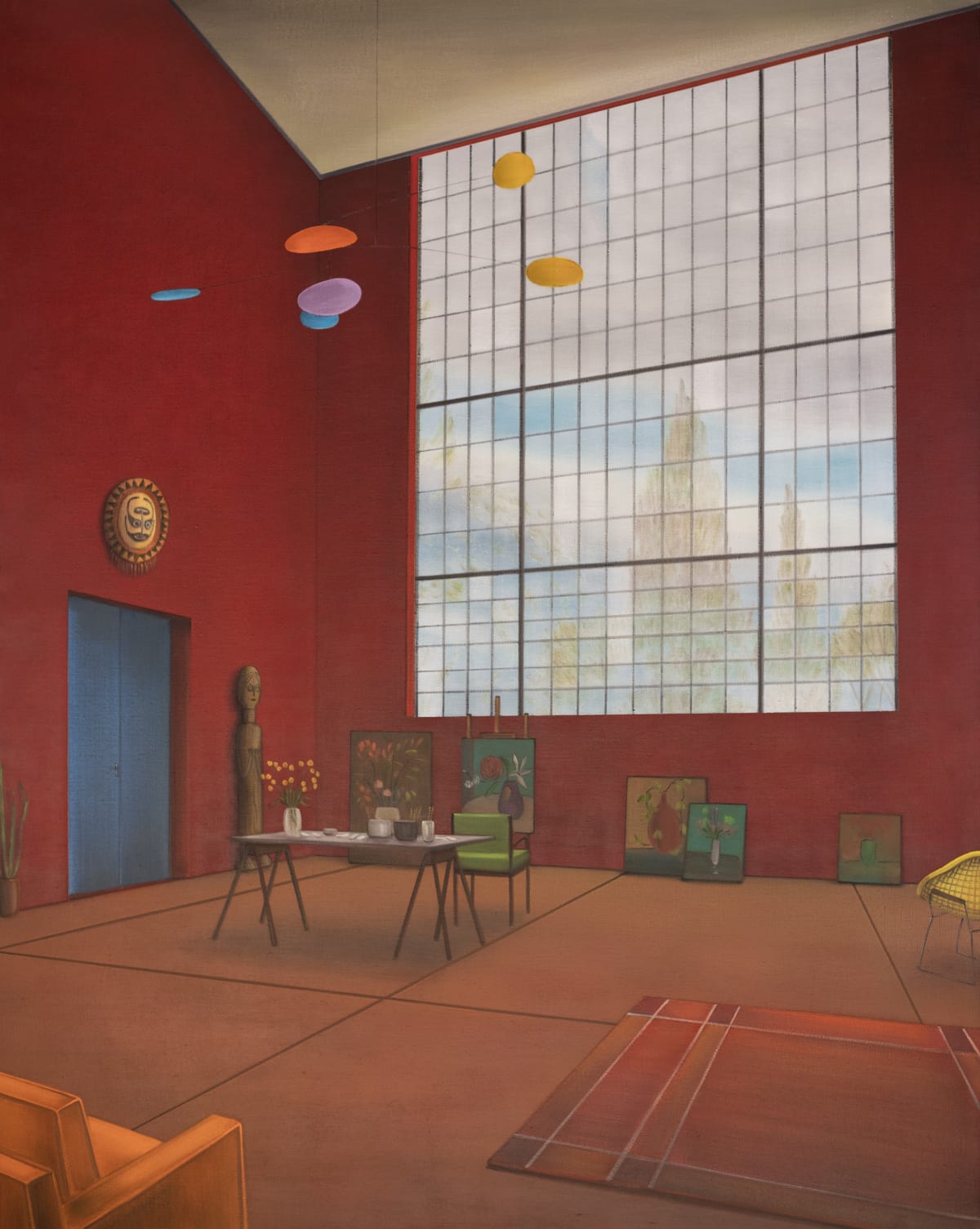Studio X: Graham Fletcher
Graham Fletcher’s newest body of works treat the artist studio not simply as a site of production, but as a curated, self-reflexive environment. They have been inspired by Matisse’s The Pink Studio (1911), which comes from a lineage of 20th century artists exploring the studio as subject and as a charged site of introspection. Studio X presents ten paintings that operate within a layered visual and conceptual space, where tribal artefacts, modernist references, and mid-century furnishings converge. The “X” signals not only the Roman numeral for ten, but also to the idea of the intersection of cultures, histories, and artistic vocabularies. It further suggests a variable—a shifting value or identity yet to be fully defined.
Within each painting, disparate elements are collaged into an intercultural mise-en-scène: a stage where objects and influences are brought into proximity, not to reinforce hierarchies but to question them. Fletcher’s curated compositions create a thoughtful atmosphere that allow the subtle interplay of objects and their cultural differences to resonate. In Studio X (Red, Blue), a modernist floor lamp is placed alongside an oceanic paddle club on the wall; similar scales, yet a collision of cultures, meanings, uses and materialities. In Studio X (Red I) a Calder-esque hanging sculpture and Bauhaus-style industrial windowpanes loom over the artefacts and paintings below. In Studio X (Red Deep), multiple paintings are shown leaning on the floor and on easels, threading in references to the still-lives of French painter Pierre Bonnard. In this exhibition, the modernist canon is both referenced and unsettled. The presence of tribal forms challenges their historical marginalisation and points to the often-unacknowledged flows of cultural exchange that shaped European art. Each work in the exhibition operates as a node in this matrix, negotiating memory, aesthetics, and critical distance.
By revisiting the studio as a symbolic and spatial construct, Studio X invites viewers to consider how the act of painting itself can become a form of critical translation — one that both acknowledges influence and questions authorship. This exhibition exemplifies Fletcher’s longstanding focus on communicating a Postcolonial discourse through his concise and elegant visual language. Fletcher holds a Doctorate from Elam School of Fine Arts (2010) and is currently Principal Lecturer, Studio Coordinator of Painting at the Dunedin School of Art. His works are held in significant public and private collections including Te Papa Tongarewa, and Gow Langsford has represented him since 2014.
-
 Graham Fletcher, Studio X (Green-Gold I), 2025
Graham Fletcher, Studio X (Green-Gold I), 2025 -
 Graham Fletcher, Studio X (Blue), 2025
Graham Fletcher, Studio X (Blue), 2025 -
 Graham Fletcher, Studio X (Red, Blue), 2025
Graham Fletcher, Studio X (Red, Blue), 2025 -
 Graham Fletcher, Studio X (Green II), 2025
Graham Fletcher, Studio X (Green II), 2025 -
 Graham Fletcher, Studio X (Red II), 2025
Graham Fletcher, Studio X (Red II), 2025 -
 Graham Fletcher, Studio X (Van Dyke Brown), 2025
Graham Fletcher, Studio X (Van Dyke Brown), 2025 -
 Graham Fletcher, Studio X (Red Deep), 2025
Graham Fletcher, Studio X (Red Deep), 2025 -
 Graham Fletcher, Studio X (Green I), 2025
Graham Fletcher, Studio X (Green I), 2025 -
 Graham Fletcher, Studio X (Green-Gold II), 2025
Graham Fletcher, Studio X (Green-Gold II), 2025 -
 Graham Fletcher, Studio X (Red I), 2025
Graham Fletcher, Studio X (Red I), 2025
![Studio X (Red Deep), 2025 [detail]](https://artlogic-res.cloudinary.com/w_800,h_800,c_limit,f_auto,fl_lossy,q_auto/ws-gowlangsford/usr/images/exhibitions/group_images_override/493/fletcher_2025_studio-x-red-deep_oil-on-linen_1220-x-1530mm_afle093-25_detail.jpg)



















